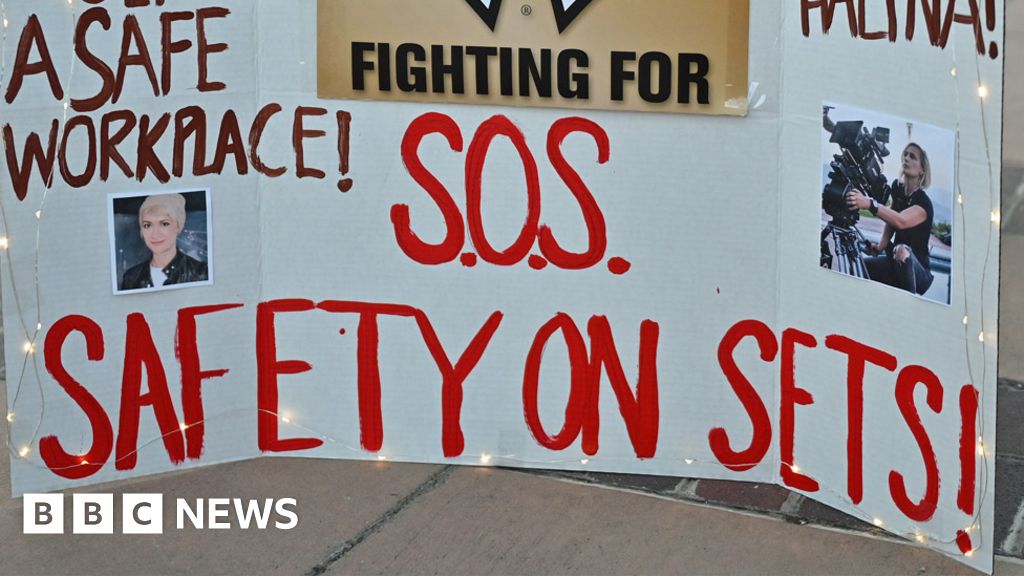If it's not supposed to be lethal - loaded with blanks - is it still a weapon?
Semantics you are playing word games ... the Rules or guidelines are never point a Weapon / firearm / Blank Firing Gun at anyone
These were implemented after Brandon Lee was shot during the filming of The Crow ...
1. a bullet was logged in the barrel of a .44 Magnum from, firing reduced load cartridges
2. the set Armor failed to check the weapon for obstructions
3. subsequently firing full power blanks dislodged the bullet killing Brandon Lee
What do we define as a "weapon"? Just something that *can* kill or injure you? Or something that's purpose is to injure or kill you?
The Firearm used by Alec Baldwin was not a Prop Gun with a solid or reduced diameter barrel designed to shoot blanks ....
but an actual Colt .45 Single Action Army Revolver
Also Baldwin was the Producer, it is my understanding he was cutting all sorts of corners, cheapening out on qualified staff the Armor was largely inexperienced A perspex shield is supposed to be between the camera crew and ANY actor firing a weapon.
Revolvers to not ' go off by themselves, you have to pull back the hammer and pull the trigger or a double action revolver has a REALLY LONG TRIGGER PULL, you know what you are doing, you are not making that move unaware.
No one should have had LIVE rounds on set, the day before several cast / set workers took this weapon out and were firing live rounds
well apparently their are no Hard and Fast Rules .... only guidelines
The regulations are under scrutiny after the death of a film-maker on the set of an Alec Baldwin film.

www.bbc.com
Perhaps the closest to a list of suggested rules is
that published by the Industry-Wide Labor-Management Safety Committee.
Its advice includes:
- Blanks can kill. Treat all firearms as though they are loaded
- Refrain from pointing a firearm at yourself or anyone else
- Never place your finger on the trigger unless you're ready to shoot
- Anyone involved in using a firearm must be thoroughly briefed at an on-set safety meeting
- Only a qualified person should load a firearm
- Protective shields, eye and hearing protection should be used by anyone in close proximity or the line of fire
- Any actor who is required to stand near the line of fire should be allowed to witness the loading of the firearms
But the committee points out its guidelines are "not binding laws or regulations" and, as Prof Leonard says, its safety document appears to have been last revised in 2003.
I am basing me information from several articles I posted at the time of the shooting when the story broke.
these are not those articles
A location manager for “Rust” says at least four people were responsible for checking the weapon that killed cinematographer Halyna Hutchins — including gun-firing star Alec Baldwin.
She noted that the armorist, assistant director and the key grip are supposed to “check the gun … no matter what’s going on on set.
“And then very lastly, the actor checks the gun,” she said of Baldwin, who was also one of the movie’s executive producers.
[clip]
Mickey-Evans noted how Gutierrez Reed — a 24-year-old former model in charge of weapons for only her second time — was “very young.
“Does that mean that she was the one that messed up? Not necessarily,” Mickey-Evans insisted, ticking off the list of other people including Baldwin who should have checked the gun.
The gun that killed cinematographer Halyna Hutchins on the New Mexico set of “Rust” was left unattended for two hours before the fatal shooting, according to a new report.
Lawyers for the western film’s armorer said the .45 Long Colt, which was not supposed to contain live rounds, could have thus been tampered with before it was handed to actor Alec Baldwin Oct. 21,
the New York Times said.
Jason Bowles, an attorney for 24-year-old movie armorer Hannah Gutierrez-Reed, told the outlet the weapon was one of three on an armorer’s tray that she handed to
assistant director David Halls, who then gave it Baldwin.
Robert Gorence, another attorney for Gutierrez-Reed, told the outlet that she loaded the guns with dummy rounds for an afternoon filming session, placed socks over them to prevent passersby from picking them up, and went off to lunch.
“Was there a duty to safeguard them 24/7?” Gorence said. “The answer is no, because there were no live rounds.”


